From picture books about bats or microscopic species, to guides about climate change and celebrating environmentalists, there's a wide range of amazing titles being published for children.
As discussed by Chae Strathie in his feature, animals are synonymous with children's literature. “I’m far from alone in being introduced to both books and animals from a very early age – and more often than not the two go hand in paw,” he says. “Along with cuddly toys and family pets, books are often a child’s first introduction to wildlife. ”
If you're looking for more reviews, check out our guides to books on mental health, mindfulness and connecting with nature, gifts for nature lovers, the best wildlife-themed games, and podcasts on wildlife and nature.
Best wildlife books for children
Luminous
By Julia Juo. Published by Greystone Books.
- Published: 2022
- Formats: Hardback

What if your body could make its own light? Following in the footsteps of a girl and her mother as they explore the world after dark, we are introduced to a wide range of creatures that do just that. Jellyfish, fireflies, forest fungi and more jump out from the dark pages of this visually striking book, offering a tantalising glimpse of a world that is so often hidden from us by our own light pollution.
There’s a lyrical quality to author- illustrator Julia Kuo’s writing, but she’s generous with the biological details too, whether it’s explaining how dragonfish shine a red light that enables them to find their prey in the dark ocean, or how piddock clams light up the hands and mouths of those who eat them.
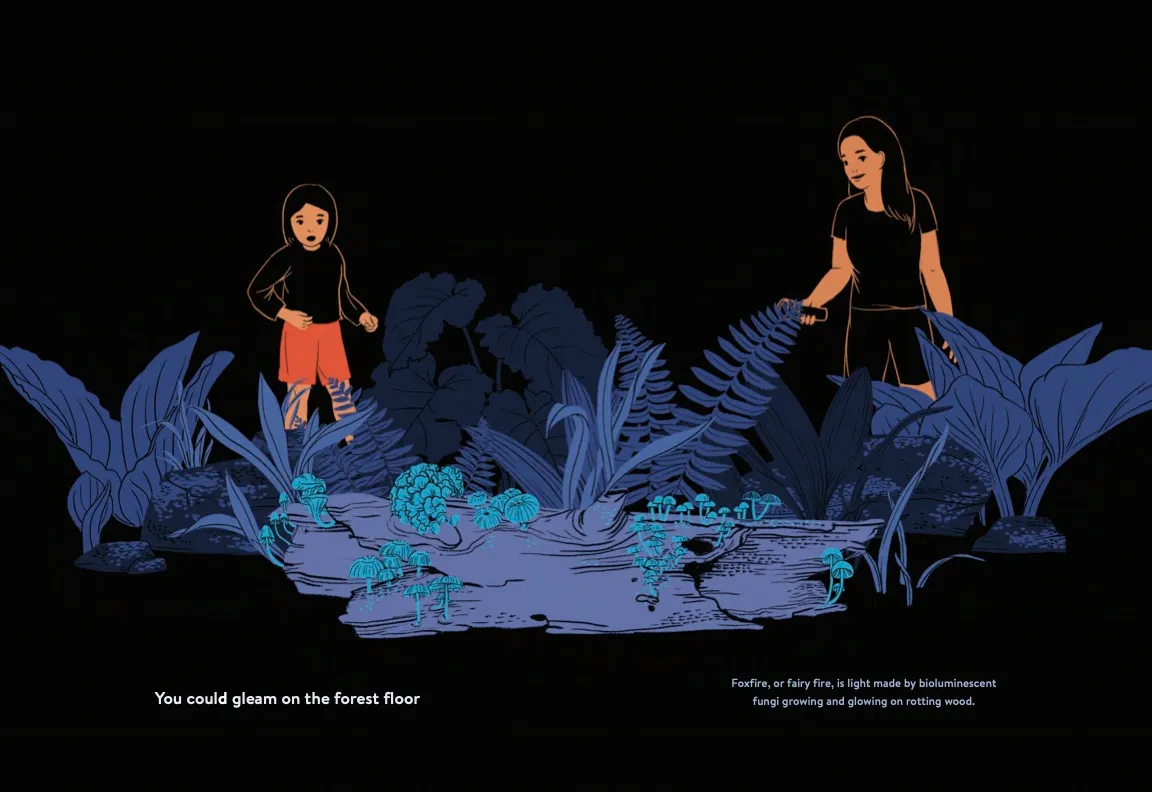
This charming book’s tone is one of wonder at the extraordinary abilities of animals all around us, but it doesn’t shy away from the difficult subject of how humans negatively impact the environment. As Kuo puts it, “If we used less light, what could we see?”
Reviewed by Jo Caird, freelance writer
Secret World of Plants
By Ben Hoare. Published by DK.
- Published: 2022
- Formats: Hardback

With over a third of the world’s plants under threat, it’s never too early to inspire the next generation with the magic of the plant kingdom. And, as BBC Wildlife regular Ben Hoare expertly demonstrates in his latested sumptuously illustrated books for younger readers, there’s a lot of magic to marvel at.
We begin with leaves – what they are, how they work, and how they evolved since the earliest plants first sprouted some 500 million years ago. Simple, clear presentation means you get to the heart of the matter in an instant, and examples of different species are used cleverly to demonstrate the diversity of plant life in the UK and around the world.

But it is through looking at the many ways plants defend themselves, how they move and the myriad other remarkable things they do that the layers of plant complexity are revealed. Be warned - if you buy this for one of the youngsters in your life, they’re going to have to prise the book out of your hands first.
Reviewed by Paul McGuinness, editor, BBC Wildlife
We Have A Dream
By Dr Mya-Rose Craig, illustrated by Sabreba Khadija. Published by Magic Cat Publishing.
- Published: 2021
- Formats: Hardback (£12.99)
Buy now from:

Since she was a young girl, Mya-Rose Craig has passionately advocated for the voices of young and diverse people in the environmental movement. Such vital viewpoints are often missing from these important climate change discussions. Her new book is a visceral, powerful collection of global voices from indigenous people and people of colour discussing their hopes for a better future.

Young readers will be deeply humbled by their stories, especially those contributors who describe the impacts of climate change on their communities, such as Carlos Manuel and Caitlyn Baikiean.
The illustrations are striking and dynamic, giving force to the narrative, which centres on a call to action for the benefit of all. This is a vital and impressive read and one that will inspire climate activists, both young and old.
Reviewed by Dr Anjana Khatwa, earth scientist and presenter
Wild Child
By Dara McAnulty, illustrated by Barry Falls. Published by Macmillan.
- Published: 2021
- Formats: Hardback (£12.99)
- Age range: 7-11 years
Buy now from:

Fresh from the success of his rightly lauded and multi award-winning book Diary of a Young Naturalist (reviewed further down in this article), teenage conservationist Dara McAnulty has written an alluring family guide to the wonders of nature. Wild Child fuses poetic evocations with fact files and activities to inspire and engage readers, celebrating the awe that first took Dara out into the wild.

And while Wild Child does appeal to younger readers – my seven-year-old says it’s brilliant – it also serves as a reminder to us grown-up children of those early explorations – adventures when we delved deep into the undergrowth to examine dandelions and ladybirds. Reading as a family, we laughed together at the miscellany of names for woodlice (I knew them as chuggy pegs, but in other parts of the country they’re apparently called penny sows, cheese logs or monkey-peas); we all had our senses tickled by Dara’s joyful skill with words; and, after reading, we all put the book down and headed out through the back door.
Reviewed by Paul McGuinness, editor, BBC Wildlife
Let's Go for a Walk
By Ranger Hamza, illustrated by Kate Kronreif. Published by Ivy Kids.
- Published: 2021
- Formats: Paperback (£7.99)
- Age range: 3-6 years
Buy now from:

Super-bright, engaging, accessible… this book is a blast of fresh air. Its 15 cheery spreads are pitched at early readers and inspired by the popular CBeebies series with Ranger Hamza, featuring the alter ego of wildlife photographer Hamza Yassin. Whereas children’s wildlife books often focus on identifying species or learning basic biology, this one is much less prescriptive. The emphasis is as much on sharing the thrill of spotting natural things, noticing what they look, feel or sound like, and discovery through wild play.

Loosely based around nature rambles, Kronreif’s artwork shows urban settings as well as the idyllic ponds, woods and coasts that are the staple fare of similar books. Also refreshing, the multi-racial characters look like contemporary Britain. Wildlife is for everyone, urges the rhyming text. My daughters commented that the book is great fun, with one saying: “I wished I’d had it when I was younger, daddy!”
Reviewed by Ben Hoare, editorial consultant, BBC Wildlife Magazine
Save Our Species: Endangered Animals and How You Can Save Them
By Dominic Couzens, illustrated by Sarah Edmonds. Published by Harper Collins.
- Published: 2021
- Formats: Hardback (£10.99)
Buy now from:

Hot on the agenda of nature lovers everywhere is how to protect the wildlife we live with. Save Our Species: Endangered Animals and How You Can Save Them by Dominic Couzens is a practical guide to understanding and preserving 30 plants and animals that are on the decline in Britain, especially since the 1950s and 1960s.

With illustrations from Sarah Edmonds, there’s loads of information about well-loved creatures like puffins, seahorses and nightingales, but there are also narratives of lesser known British animals such as the pink sea fan found in deep waters of the south-west; the shrill carder bee, now in just seven counties; and the grey long-eared bat, resident along the south coast of England.
In each fact file, Couzens offers a description of the threats posed to each species and suggestions on what we need to do to give them the best chance at survival. Throughout the book, there are examples of how to champion the environment with action and advocacy.
Reviewed by Zakiya McKenzie, nature writer
Earth's Incredible Oceans
By Jess French, illustrated by Clare McElfatrick. Published by Dorling Kindersley.
- Published: 2021
- Formats: Hardback (£14.99)
- Age range: 7-9 years
Buy now from:

A sign of a really informative children’s book is when the parents learn something new too; in this book, the caption ‘Moon Jellyfish can get younger as well as older’ had this parent searching the web for background reading!
Earth’s Incredible Oceans is attractively laid out, each page filled with an ocean scene packed with a mix of photographs, illustrations, and short interesting facts. The target audience of 7- to 9-year-olds will enjoy the easy-to-read and fascinating captions, but the engaging illustrations will draw in children of all ages, so it also works as a picture book for younger children.

In our family, it prompted discussions on such absorbing topics as ‘do starfish die if they freeze in a brinicle?’ and ‘what happens if you dig down beneath the seabed?’. The book covers animals, habitats, ocean geography and ecological concepts such as food webs, making it a genuinely educational resource.
Reviewed by Kate Risely, ornithologist
Activists Assemble – Save Your Planet
By Ben Hoare, illustrated by Jade Orlando. Published by Pan Macmillan.
- Published: 2021
- Formats: Paperback (£8.99)
- Age range: 8-11 years
Pre-order now from:

Getting any reader to grasp the urgency of our planet’s environmental threats, without reducing them to hopelessness and eco-anxiety is a mighty task. Hats off to the author - he strike a fine balance.
Morbid challenges like population growth, habitat loss and hunting are told in truth but are equally balanced with colourful, playful illustrations. Diverse wildlife ambassadors flood the pages, creating a powerful tool in galvanising positive change and impact driven by individuals. You want to be part of it.

There’s no over technical language to get bogged down in ensuring important messages are accessible and digestible. However, crucial statistics are easily swallowed up among the copy and illustrations.
Solutions are plentiful. Actions are achievable and tangible. The book concludes with an interactive section to plan your first set of eco-friendly actions. For any reader, change is on the horizon - this book powerfully guides you to commit to solutions and with confidence.
Reviewed by Emma Oldham, communications specialist
When We Went Wild
By Isabella Tree, illustrated by Allira Tee. Published by The Ivy Press.
- Published: 2021
- Formats: Paperback (£7.99)
- Age range: 4-7 years
Buy now from:

The real skill of successful conservation lies in the ability to communicate complicated, scientific concepts to as many people as possible, including children. Isabella Tree is one such communicator. When We Went Wild tells the story of two farmers who make the shift from industrial farming to rewilding, and the wonderful benefits that this brings for wildlife, their community, their animals and for them.
The story is understandably simplified, perhaps a little too, and I can imagine eagle-eyed young children (5-8) pestering parents and teachers with questions: “but why did the land soak up the water, mummy?” “Miss, why do people use chemicals if they kill all the animals?”

The exquisitely detailed illustrations from Allira Tee bring the whole to life, even if the opening pages are a little heavy. This lovely book is based partly on Isabella’s own experiences at Knepp Wildland in Sussex and would sit brilliantly on any nature-loving child’s bookshelf.
Reviewed by Lucy McRobert, nature writer
Funny Bums, Freaky Beaks: and Other Incredible Creature Features
By Alex Morss and Sean Taylor, illustrated by Sarah Edmonds. Published by Welbeck Publishing Group.
- Published: 2021
- Formats: Hardback (£12.99)
- Age range: 6 years and above
Buy now from:

Behind every kid that knows all the animal facts, there is a well-thumbed compendium like this one. Full to the brim with all sorts of extraordinary adaptations, the authors take us on a journey across body parts through page-after-page of lavishly illustrated spreads. Odd Noses, for example, sees us explore sawfish bills, echo-locating nose-leafed bats and the twitching noses of elephant shrews. Likewise, Funny bums sees us load up on facts about manatees (they fart), Eastern spotted skunk (they stink) and the crested macaque (it’s pink).

Factually, there’s plenty to enjoy but some readers might expect more. Natural selection, the engine driving the astonishing adaptations in the book, gets barely a look-in, for instance. And there is no reference to how scientists go about actually discovering these facts in the first place. Without this, the book remains a little two-dimensional. The kids that like to be told, will be well-served. The ones that want to be shown, less-so.
Reviewed by Jules Howard, wildlife writer
The Great Barrier Reef
By Helen Scales, illustrated by Lisk Feng. Published by Flying Eye Books.
- Published: 2021
- Formats: Hardback (£14.99)
- Age range: 5-7 years
Buy now from:

One of the planet’s greatest natural wonders twinkles and beguiles in this charming book – the first for young readers by Scales, a regular BBC Wildlife contributor. Like all the best children’s illustrated non-fiction, there is enough here to interest and surprise grown-ups too, but never at the expense of concision or clarity.
In 40 perfectly paced spreads, we learn about the reef’s natural and human history, including its importance (often overlooked) in the culture of Aborigines and Torres Strait Islanders, and pick up tidbits about reef exploration and science. Conservation messages are necessarily powerful, without being overwhelming.

Scales uses just the right amount of chattiness and wordplay, while Feng’s award-winning artwork reveals secrets from the underwater world, such as a parrotfish tucked into its mucus sleeping bag, or a spawning reef that shimmers like a snow globe.
Reviewed by Ben Hoare, editorial consultant, BBC Wildlife Magazine
Water World
By Ben Rothery. Published by Penguin Random House Children's UK.
- Published: 2021
- Formats: Hardback (£20.00)
- Age range: 4 years and above
Buy now from:

This is clearly a personal book for author and illustrator Ben Rothery. The introduction and conclusion, a letter to the reader, connect our oceans with human life and play on the strong emotional and physical relationship between ourselves and life under the sea. The letter is a call to arms and a stark reminder of the fragility of oceans, balanced with hope, campaigning and empowerment.
The illustrations lift the book to another level, being beautifully drawn, striking and capturing some more unusual species, like whale lice and mangrove horseshoe crabs, balancing the spectacular with the more obscure. The text that accompanies them is informative.

At times the structure feels a little random; including wolves and tigers alongside mudskippers for example. Overall, this is a great book for kids interested in marine life, offering a solid introduction to the biology of the sea and how people can take action to save it.
Reviewed by Lucy McRobert, nature writer
Fantastic Beasts: Amazing Animals and the Magical Creatures of Harry Potter and Fantastic Beasts
Published by Bloomsbury and the Natural History Museum
- Published: 2020
- Formats: Hardback (£25.00)
Buy now from:

This book will be a delight for both naturalists and Harry Potter fans, and the perfect combination for those that are both. Accompanying the exhibition at the Natural History Museum in London, the book explores the magical creatures from J.K.Rowling’s Fantastic Beasts and Where to Find Them, as well as the mythological and real, but bizarre and awe-inspiring, creatures of our Muggle world.

Each chapter begins with an essay, written by a range of experts and conservationists, including marine biologist Dr Helen Scales, Springwatch presenter Gillian Burke and natural history writer Patrick Barkham. Packed with a wide range of content, this is a book to return to again and again.
Reviewed by Megan Shersby, editorial and digital co-ordinator, BBC Wildlife
Snow Birds
By Kirsten Hall, illustrated by Jenni Desmond. Abrams Books.
- Published: 2020
- Formats: Hardback (£12.99)
- Age range: 4-8 years
Buy now from:
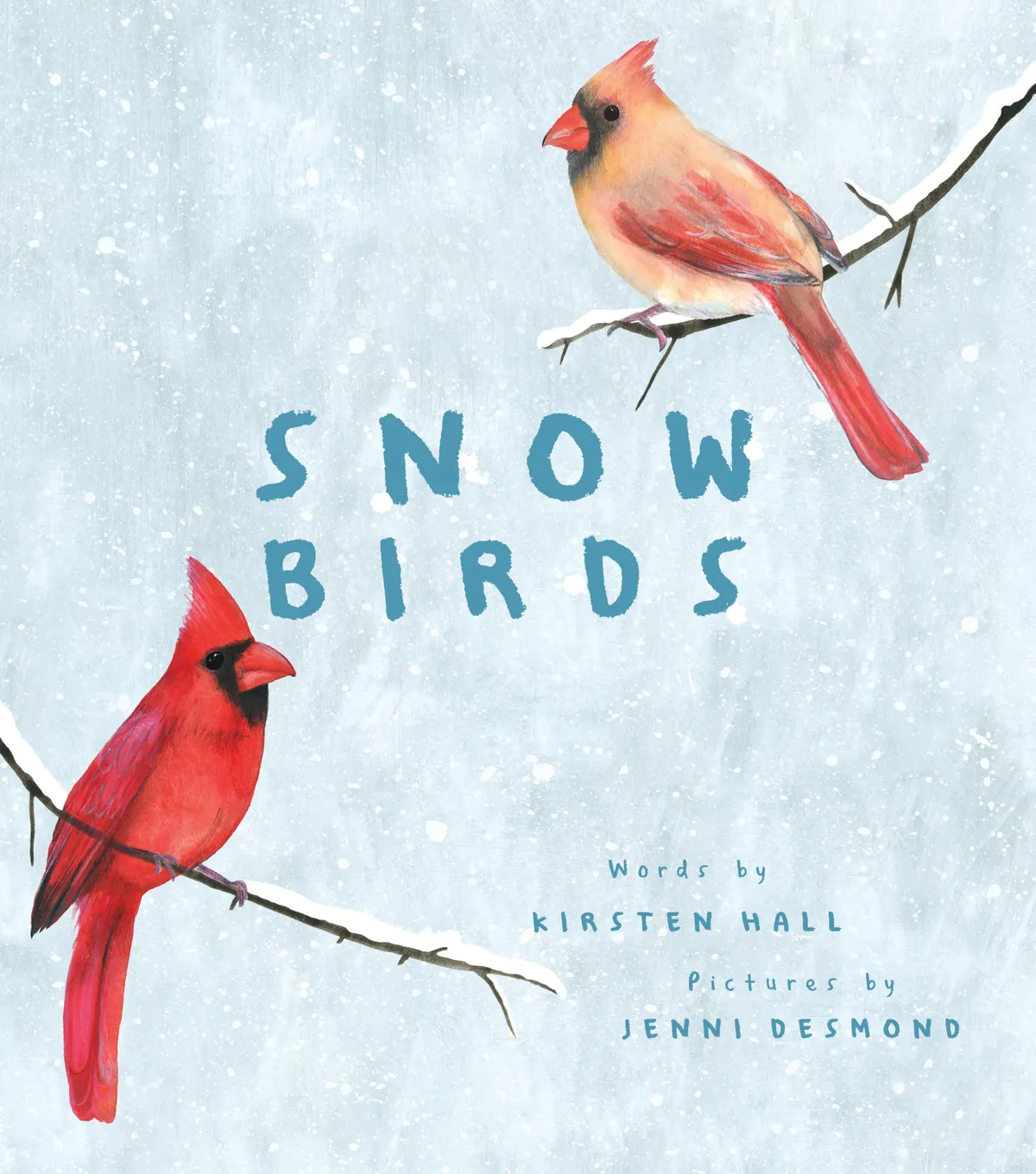
This book feels special from the moment you pick it up. Set in North America, each poem describes a different species and the challenges they face in winter: the great grey owl hunts for its next meal in three lines; golden-crowned kinglets huddle together for warmth; and the northern cardinal is filled with rhythmic hope of a coming spring.
Each poem captures the behaviours of the bird, not just in words but in construction, and is accompanied by the bird’s song and a captivating illustration. You can hear the downy woodpecker drilling and feel the solitude of the snowy owl perched atop a dune.

Curl up under a blanket with your little one and lose yourself in the elegant, descriptive poetry and striking artwork, which exquisitely depict the most dramatic season of the year. The perfect gift for children aged five and upwards, it will open their imaginations to a new world in winter.
Reviewed by Lucy McRobert, nature writer
Wild City
By Ben Hoare, illustrated by Lucy Rose. Published by Pan Macmillan.
- Published: 2020
- Formats: Hardback (£12.99), and paperback due out in September 2021 (£12.99)
- Age range: 7-11 years
Buy now from:

Did you know that moose are on the loose in Anchorage, Alaska or that giant orca live along the coast in Vancouver, Canada? We naturally think about towns as places for people but many animals are happy to live close to our doorsteps, too. Wild City introduces some of the magnificent wildlife among us every single day.
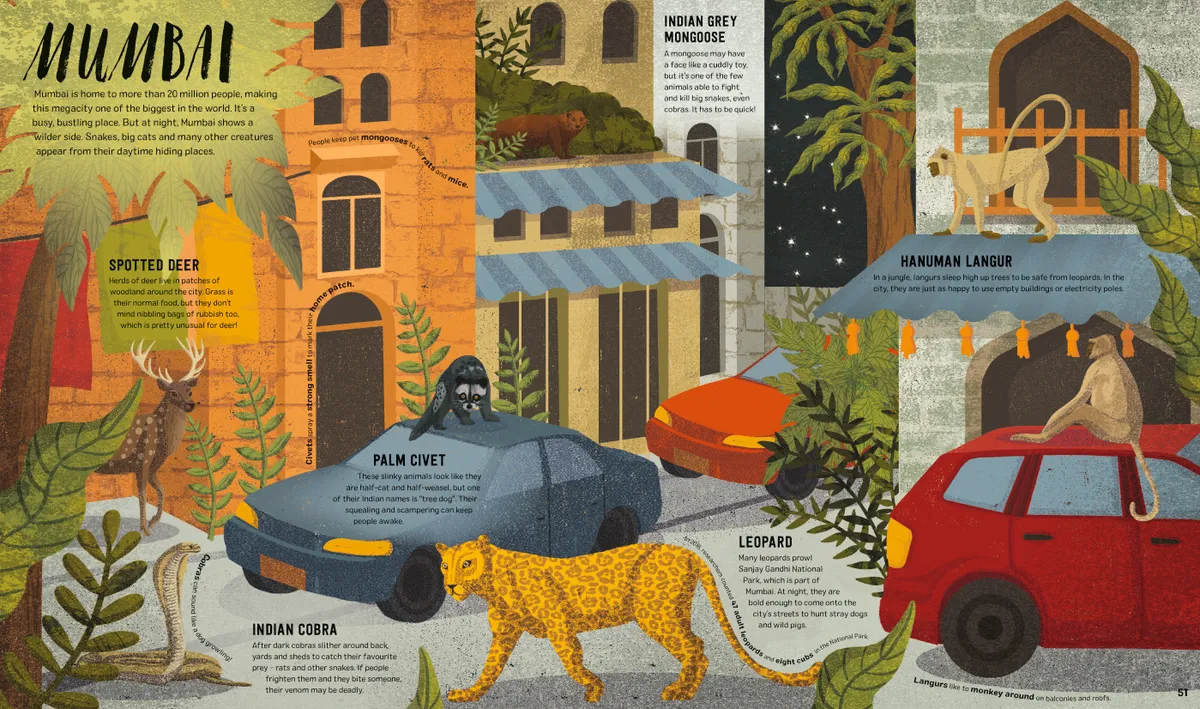
Interesting facts give explanations of how different urban settings help animals thrive – you’ll find out why Cape Town’s weather attracts lots of sea life, and where reptiles like to hang out in Bangkok – while detailed illustrations will leave you with an impression of what these global cities feel like overall. The countryside is welcoming for its own finds, but Wild City shows us that you don’t have to leave town to discover the cool wildlife around.
Reviewed by Zakiya Mckenzie, writer
The Lost Spells
By Robert Macfarlane. Illustrated by Jackie Morris. Published by Hamish Hamilton.
- Published: 2020
- Formats: Hardback (£14.99)
- Age range: 5 years and above
Buy now from:

Take a deep well of love for the more-than-human world, throw in sorrow at what we have lost, fury at what we might yet lose, and stir well. The magic that conjured up The Lost Words three years ago is back, this time in pocket- sized form. Many publishers have tried to replicate the feel of that beautiful bestseller, but once again, Macfarlane’s impish wordplay and Morris’s sensuous paintings prove to be a class apart – a match made in heaven.

With their chanting rhythms and tongue-twistery, the 21 new nature poems (or ‘spells’) demand to be read aloud and shared, entrancing young children as surely as grown-ups. Some fill a spread, while others dance and sing over eight pages, all bookended by beguiling, gilded scenes... shape-shifting foxes, fluttering moths, slippery seals, life-giving silver birches. This book is bound to appear under many Christmas trees, for both children and adults.
Reviewed by Ben Hoare, editorial consultant, BBC Wildlife Magazine
The Brilliant Book of Animal Bones
By Anna Claybourne. Published by Hatchette.
- Published: 2020
- Formats: Hardback (£12.99), and paperback due out in October 2021 (£8.99)
- Age range: 8-11 years
Buy now from:

Take a peek inside the bodies of humans and other animals in this fascinating guide to skeletons. Beginning with an introduction to what exactly bones are, and the difference between vertebrates and invertebrates, this book takes a look at a range of species, the differences between them, and how their skeletons are adapted for their lives. For example, did you know that despite having such a long neck, giraffes have only seven neck bones, the same number as humans, and most other mammals? Though they are, of course, much larger – up to 25cm!

There’s a good range of species represented across the five groups of vertebrates (fish, amphibians, reptiles, birds and mammals), and with plenty of surprising facts to learn, it’s an excellent book for returning to again and again – for children and adults.
Reviewed by Megan Shersby, editorial and digital co-ordinator, BBC Wildlife
Tiger, Tiger, Burning Bright! An animal poem for every day of the year.
Selected by Fiona Waters, illustrated by Britta Teckentrup. Published by Nosy Crow.
- Published: 2020
- Formats: Hardback (£25.00)
Buy now from:

A few years ago, it seemed like the key to getting a book published was to tell the tale in 100 objects. The current trend has seen the number rise, as umpteen books promise a this, a that or another for every day of the year. So it came as something of a pleasant surprise to encounter Tiger Tiger Burning Bright, boasting an animal poem for every day of the year. This is no bandwagon-jumper, rather a stunning collection of 366 wonderful poems, drawn from over 400 years and 22 countries, each exquisitely illustrated.

It’s an awe-inspiring book, produced in collaboration with the National Trust, and one that might initially seem aimed at a younger reader, but delivers whatever age the reader has reached. One a day allows just enough time to digest a poem before an appetite is worked up for the next.
Reviewed by Paul McGuinness, editor, BBC Wildlife
Creature Features: Oceans
By Natasha Durley. Published by Big Picture Press.
- Published: 2020
- Formats: Hardback (£10.99)
- Age range: 5 and up
Buy now from:

Fans of Natasha Durley’s previous two Creature Features books will be pleased by this marine addition to the series. As before, each page groups together amazing creatures from around the world that all share a common body part or pattern. It’s beautifully illustrated with bold and bright artwork, particularly the spread celebrating the black-and-white species against a fantastically pink background – sunglasses may be required!

Whether you adore dolphins, sharks or whales, or perhaps even the smaller creatures, such as hermit crabs or anemones, there’s something for everyone. It’s a wonderful book to flick through briefly or to pore over in depth – I seemed to notice something new each time I picked it up!
Reviewed by Megan Shersby, editorial and digital co-ordinator, BBC Wildlife
Rex the Rhinoceros Beetle
By M.G. Leonard, illustrated by Duncan Beedie. Published by Scholastic.
- Published: 2020
- Formats: Paperback (£6.99)
- Age range: 3-5 years
Buy now from:

It’s safe to say that author MG Leonard thinks that beetles are fab. Her award- winning, best-selling Beetle Boy trilogy turned into an international success story, wowing aged-7+ readers with stories starring curios Coleoptera. With Rex the Rhinoceros Beetle, she takes her passion for these insects to a younger audience with this bedtime book for pre- schoolers, beautifully illustrated by Duncan Beedie.

The titular Rex is called upon by his buddy Buster to help carry a banana through the rainforest to the beetle tree. Along the way, Buster boasts of his bravery, but when the banana is nabbed by a passing monkey, it falls to Rex to save the day. If Rex proves half as popular as Beetle Boy then these scarabs are all set to introduce a new generation to beetlemania.
Reviewed by Paul McGuinness, editor, BBC Wildlife
Amazing Islands: 100+ Places that will Boggle Your Mind
By Sabrina Weiss, illustrated by Kerry Hynman. Published by What On Earth Books.
- Published: 2020
- Formats: Hardback (£14.99)
Buy now from:

The eruption in 2014 of an underwater volcano in the South Pacific gave birth to the island of Hunga Tonga-Hunga Ha’apai, one of the world’s newest islands. And while scientists expected it to be washed away within months, today, it is reported to be home to flowering plants and even burrowing owls. In 2018, Hurricane Walaka washed away the whole of Hawaii’s East Island, home to Hawaiian monk seals and green sea turtles.
As a reminder of the impermanence of everything we take as stable, Amazing Islands is aptly named. Beautifully illustrated, this isn’t a natural history so much as a look at islands of every kind – from the unique wildlife on Madagascar to the culture of island nations. Along the way, we explore the geological wonders and artificial islands.

There’s no great depth to any one subject but, as an overview, Amazing Islands is more than enough to whet the appetite for discovery.
Reviewed by Paul McGuinness, editor, BBC Wildlife
Diary of a Young Naturalist
By Dara McAnulty. Published by Little Toller.
- Published: 2020
- Formats: Hardback (£16.00), and paperback due out in March 2021 (£9.99)
Buy now from:

I admit I was anxious when I opened Dara McAnulty’s diary. It isn’t fair to expect greatness from a 15-year-old – let alone from one known to be painfully self-deprecating and burdened with eco-anxiety and existential angst. The book covers an ordinary, extraordinary year in which the autistic young campaigner (now 16) lingers on the brink of adulthood – still as likely to skip and clap as he is to belt out a rousing oration to thousands of people.
Dara writes of his ordinary-extraordinary family in Northern Ireland and the ordinary-extraordinary nature he loves, with passion, humour and searing eloquence. It made me laugh, cry, cringe and sigh, and reminded me startlingly of who I once was and who I once wanted (deep down still want) to be.
[Since it's published, A Diary of a Young Naturalist has received a number of awards, including the 2020 Wainwright Prize for UK Nature Writing.]
Reviewed by Amy-Jane Beer, wildlife writer
The Big Book of Blooms
By Yuval Zommer. Published by Thames & Hudson.
- Published: 2020
- Formats: Hardback (£12.95)
- Age range: 3-5 years
Buy now from:

From the off, it’s clear that this is an impressive book. Gorgeous illustrations flood every page, and short, accessible chunks of copy offer an incredibly full introduction to botany.
We begin at the beginning with an overview of flower families, anatomy and pollinators, before delving deeper. Why are roses red and violets blue? What are flowers actually for? How do seeds disperse? Can plants defend themselves? And so on. Beyond science, we learn about flowers in different cultures, and how and why we might grow them ourselves.

As with all the best children’s reference books, this title comes highly recommended for grown-ups, too. Every time my son gleaned some nugget from the book and turned to me asking “Is that true, Daddy?” I was conscious not only of the wonder of nature blooming in him, but also getting a refresher of the miracle of plant life for myself.
There is an accompanying sticker book (paperback, £8.95): Amazon UK, Bookshop, Hive, Waterstones.
Reviewed by Paul McGuinness, editor, BBC Wildlife
The Brilliant Book of Bugs
By Jess French, illustrated by Claire McElfatrick. Published by DK.
- Published: 2020
- Formats: Hardback (£14.99)
- Age range: 5-9 years
Buy now from:
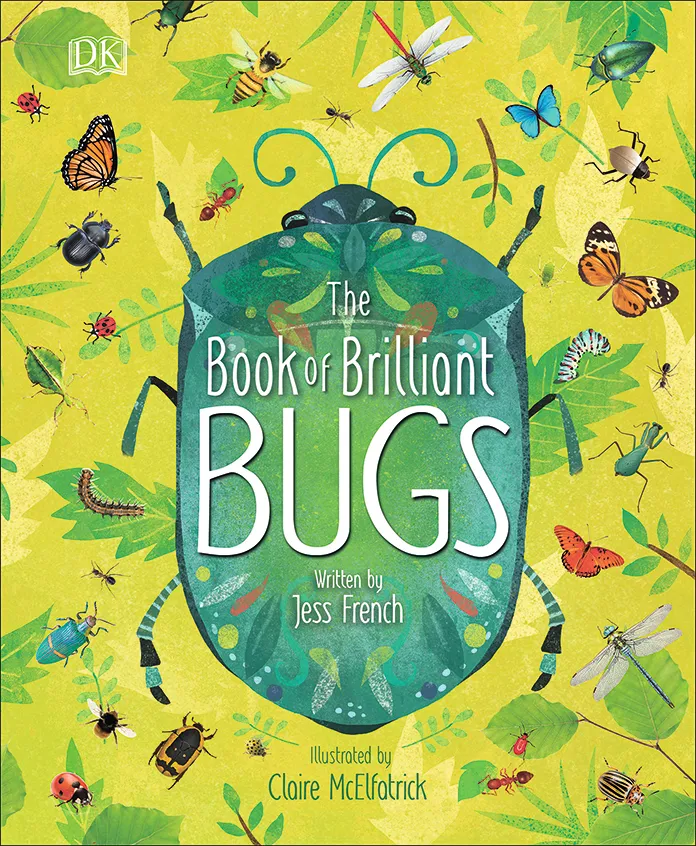
This stunningly visual book is certain to inspire children and adults alike to take a closer look at the world of minibeasts. The vibrant cover hints at what’s waiting to be discovered among the book’s page – including bees, butterflies and some awesome leaf insects.
Children’s natural curiosity is bound to be piqued by the family trees and beautiful illustrations, which give readers a closer look at the anatomy of certain insects, such as the praying mantis and its incredible adapted front legs, or how a butterfly feeds using its proboscis. The book is full of interesting facts that will appeal to youngsters – did you know that a fly’s mouthparts are like sponges, sucking up soft food and liquids?

Author Jess French, not one to shy away from the world’s climate issues, touches on these problems towards the end of the book but does so in an informative yet friendly way, showing readers how they can help protect and preserve the natural world around them.
Reviewed by Matt Doogue, wildlife photographer
The Not BAD Animals
By Sophie Corrigan. Published by Frances Lincoln.
- Published: 2020
- Formats: Hardback (£14.99)
- Age range: 5-10 years

While many nature books focus on familiar ‘wow- species’ to attract the attentions of young people, The NOT Bad Animals tries a more comedic approach. Through a series of colourful and cartoonish spreads, it sets its target firmly on the animals that most people unfairly detest and, with its own brand of enthusiastic, frothing positivity, argues that these animals are far more incredible than we dare to dream.
Thus spiders, lampooned in one spread for being monstrous night-time nasties, are in the following spread argued to be vital, charismatic bug-catchers that carefully recycle their own webs by eating them. Crows aren’t creepy – they’re faithful parents, we’re told. Likewise, foxes aren’t fiendish – they can be friendly.

Sure, pedants will baulk at the occasional misstep (crocodiles are called both dinosaurs and lizards, for instance) but the impish, anarchic charm of this book and its relentless elation for lesser-loved animals will undoubtedly keep youngsters coming back for more.
Reviewed by Jules Howard, wildlife writer
The surprising lives of animals
By Anna Claybourne, illustrated by Stef Murphy. Published by Ivy Kids.
- Published: 2020
- Formats: Hardback (£12.99)
- Age range: 7-10 years
Buy now from:

Did you know that you can make a rat laugh by tickling it? Or that spectacled caiman babysit for each other? From farming ants to Hoover the talking seal, this book contains nuggets of information to delight and fascinate readers of all ages.
Showing that animals are more like us than we might think, it covers how some species play and learn, how they use tools and partner up, and much more. But what might be an informative and entertaining one-time read is made a real treasure by the beautiful explanatory illustrations.

As well as explaining animal behaviour, the book also touches on notable scientists and their discoveries. With a glossary and further reading included, this is the perfect springboard for any budding zoologist. And it has enough poo facts to keep kids coming back for more.
This book is perfect when it comes to teaching a nature nut something new, or sparking a new interest.
Reviewed by Emma Pocklington, nature writer
This Book Will (Help) Cool the Climate
By Isabel Thomas. Published by Wren and Rook.
- Published: 2020
- Formats: Paperback (£6.99)
- Age range: 9-11 years
Buy now from:

If everybody followed the advice in this little book, we’d stand a good chance of tackling climate change. It is full of wise ways to change your lifestyle – from altering buying, eating and even playing habits to joining in with community projects. As I read it with my 10-year-old, I learned a lot and felt guilty.
But the aim is to empower rather than frighten; to deal with defeatist attitudes such as “nothing I do is going to make a difference”. Positive change can lead to heightened self-worth, new hobbies and new friendships, though the advice to wee on your compost heap might stretch neighbourly relations.
Reviewed by Fergus Collins, editor, BBC Countryfile Magazine
The Bat Book
By Charlotte Milner. Published by DK.
- Published: 2020
- Formats: Hardback (£12.99)
- Age range: 5-9 years
Buy now from:

Unlike Bruce Wayne, bats are well-equipped with superpowers, quickly making this big book of bat facts a firm favourite with me and my son. Charmingly illustrated with a perfect blend of science and fun, The Bat Book dispenses facts with ease – within a minute we were laughing at the idea of the fastest bat (the Mexican free-tailed) flying past us on the motorway at 100mph, and streeeeeetching to see if we could copy the giant golden-crowned flying fox’s 150cm wingspan.
The more we read, the more we learned, with sections exploring why bats hang upside down, what they eat, echolocation and, deeper into the book, bats’ key role as seed dispersers and how they keep different ecosystems healthy.
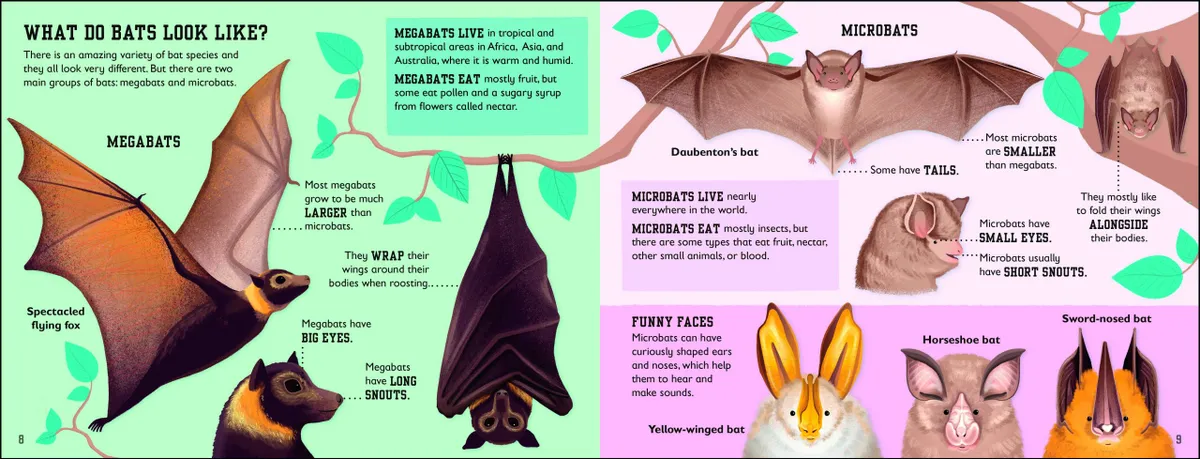
On a practical note, having learned about the threats to bats and their habitats, we’re now planning on planting some bat-friendly plants to see if we can lure any flying mammals into the garden this summer.
Reviewed by Paul McGuinness, editor, BBC Wildlife Magazine
The Natural History Puzzle Book
By Dr Gareth Moore. Published by Carlton Books and the Natural History Museum.
- Published: 2020
- Formats: Hardback (£14.99)
- Age range: 9 years and above
Buy now from:

Did you know that on a clear night the human eye can see around 19 quadrillion miles into space? And that the earliest identified puzzle was written over 4,000 years ago? These and many other fascinating nuggets of information can be found in this engaging book inspired by exhibits in the Natural History Museum.
There are over 100 challenges with three levels of difficulty, from fun mazes to tricky nonograms. Colourful, beautifully designed and a mine of facts, this book is ideal for ages 8–80, making it a great choice for a family of curious minds.
Reviewed by Margaret Bartlett, production editor, BBC Countryfile Magazine
Unseen Worlds: Real-Life Microscopic Creatures Hiding All Around Us
By Helene Rajcak, illustrated by Damien Laverdunt. Published by What On Earth Books.
- Published: 2019
- Formats: Hardback (£14.99)
- Age range: 9-11 years
Buy now from:

Microscopic ‘mini-fauna’ rarely receives even a footnote in most children’s books. Unseen Worlds attempts to put that right with a series of dramatic dioramas of everyday habitats and the tiny, but no less charming, animals they contain.
The fibres of your bed, a dusty kitchen corner, a tuft of moss – page-by-page, each microhabitat is zoomed in upon and exposed as a vibrant hotbed of tank-like pseudoscorpions, monster-like mites, cumbersome tardigrades and serpentine worms. Each miniature organism has a role or purpose, we’re told, no matter how small.
Crucially, scale-bars and species’ labels on each page keep the focus on science, plus there is a handy section about how microscopes work and the history of microscopy to inspire a new generation of wannabe microbiologists.

Unseen Worlds delivers a simple message that resonates throughout: think small, understand big. It’s a jungle out there. Everywhere.
Reviewed by Jules Howard, wildlife writer
Earth Heroes
By Lily Dyer. Published by Nosy Crow.
- Published: 2019
- Formats: Hardback (£9.99)
- Age range: young adults
Buy now from:

When I asked my 11-year-old who he associates with saving the planet, he instantly fired back the names David Attenborough and Greta Thunberg. Both, fittingly, are on the cover of this colourful little hardback.
But while they clearly deserve their chapters, it’s the lesser-known of the 20 heroes introduced here that I want my son to read about – such as William Kamkwamba, the 14-year-old from Malawi who built a windmill from junk; and Isabel Soares, who saved tonnes of food waste in Portugal by persuading people to eat less-than-perfect fruit.
Given the gloomy environmental prognoses our kids are growing up with, this anthology is an inspiring reminder that even small actions make a difference.
Reviewed by Sarah McPherson, section editor, BBC Wildlife Magazine
Snow Leopard: Grey Ghost of the Mountain
By Justin Anderson, illustrated by Paul Benson. Published by Walker Books.
- Published: 2019
- Formats: Hardback (£12.99) and paperback (£7.99)
- Age range: 5-7 years
Buy now from:

The formula for Walker Books’ nature series is a blend of evocative writing, supplementary facts and sumptuous illustrations, and it’s a winner: they’ve been favourites in our family since long before my son could read. He’s now eight – arguably a bit old for picture books, but he seized upon this latest offering by natural history film-maker Justin Anderson.
He is also a big fan of David Attenborough, so we were less than four pages in before he recognised the story from Planet Earth II, on which Anderson spent three years working.
The book provides an accessible context for that extraordinary footage and the limited palette of Patrick Benson’s illustrations perfectly evokes the hypnotic beauty of the Himalayan landscape and its most celebrated inhabitant.

Reading it prompted a wide-ranging conversation about the tenacity of wildlife film-makers, the challenges shared by humans and snow leopards, and the uncertain future of an iconic species.
Reviewed by Amy-Jane Beer, wildlife writer
Through the Animal Kingdom
By Derek Harvey, illustrated by Charlotte Pepper. Published by DK, £9.99
- Published: 2019
- Formats: Hardback (£9.99)
- Age range: 5-9 years
Buy now from:

This enticing book relates 13 remarkable animal stories, such as an Amur leopard stalking prey through snowy Siberia and the perilous migration of wildebeest across parched African grasslands.
Harvey deftly avoids the risk of triteness inherent in such an unabashed ‘greatest hits’ of the natural world. His understated text provides an easy read, packed with insight.
But Pepper’s artwork – delightful collages blending photographs with sassy illustrations – makes the book truly special.
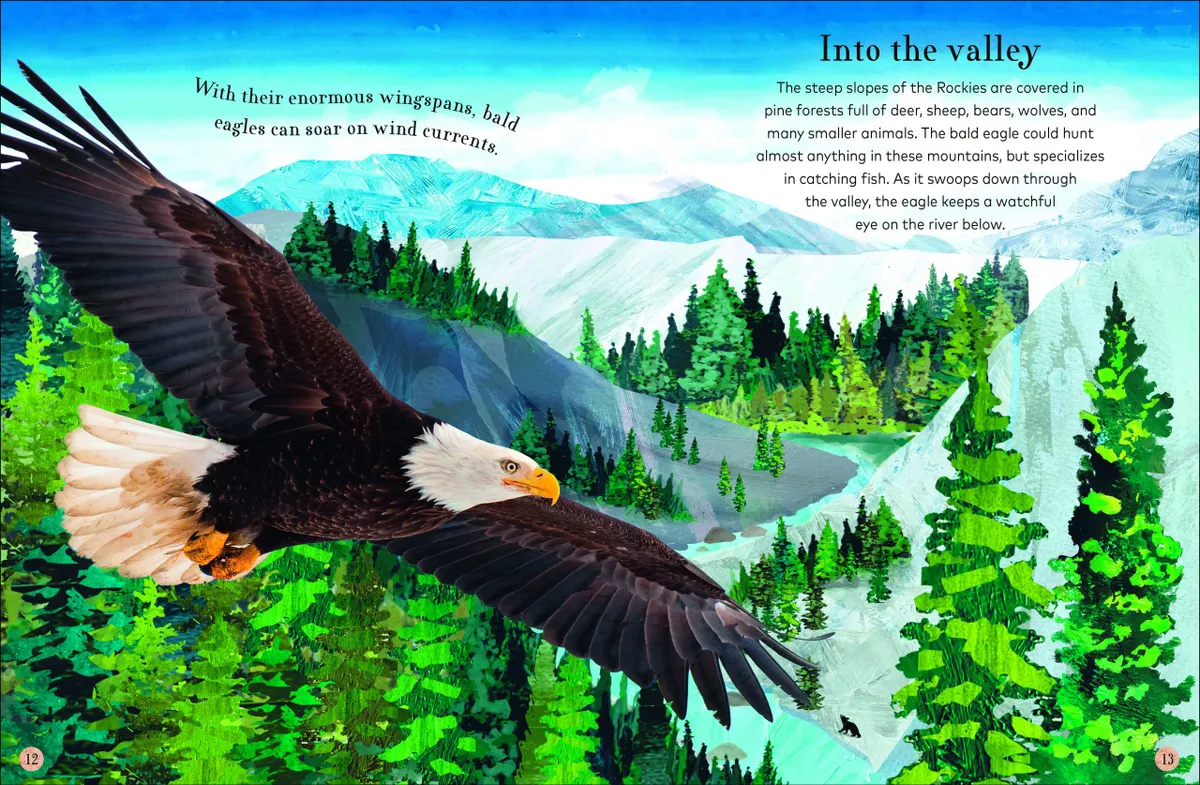
Reviewed by James Lowen, nature writer
Encyclopedia of Animals
By Jules Howard, illustrated by Jarom Vogel. Published by Wide Eyed.
- Published: 2019
- Formats: Hardback (£14.99)
- Age range: 5-9 years
Buy now from:

Illustrated children’s non-fiction is booming, especially books with an environmental tilt. This encyclopedia also follows the current trend for eschewing photographs in favour of stylised, pleasingly ‘retro’ artwork.
As a boy, I would have adored it, poring over Vogel’s fabulous depictions of the weird and wonderful animals that call this planet home.
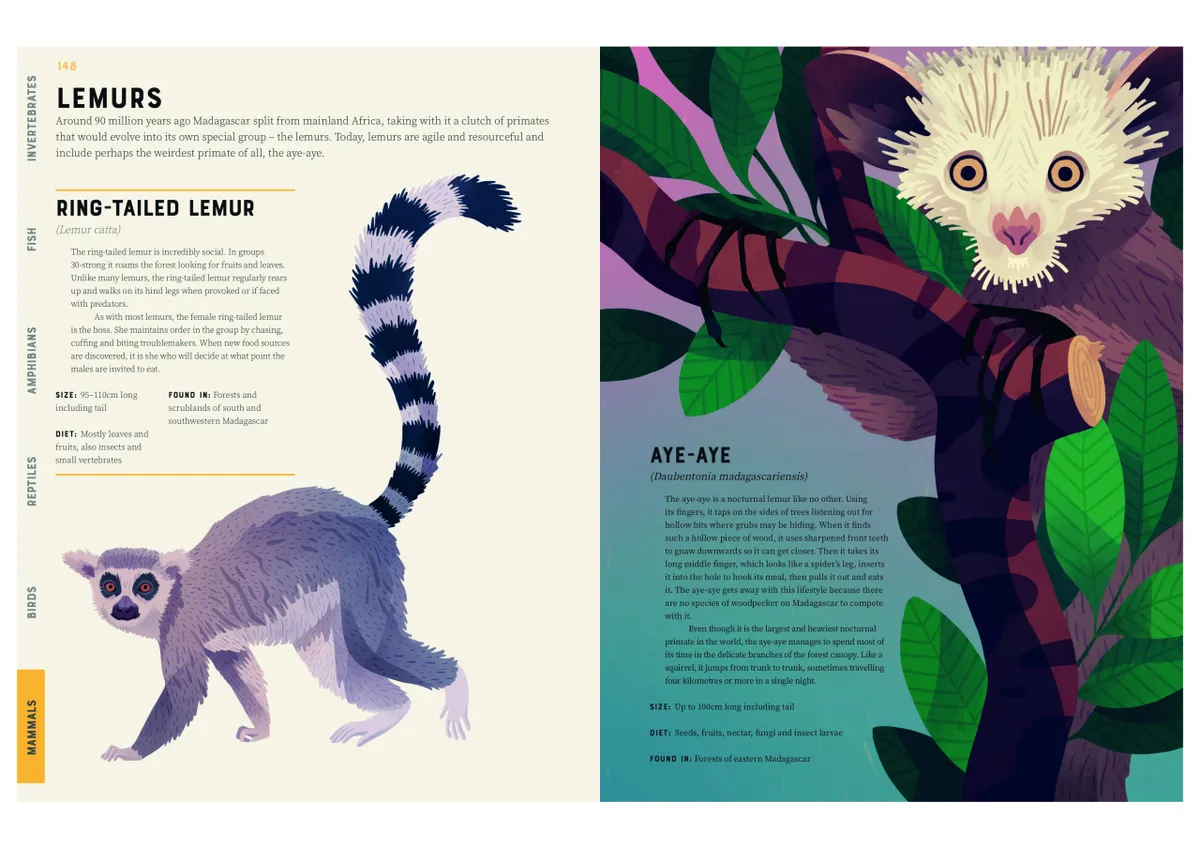
With room for just 300 species, it’s necessarily selective – of the big cats, only the lion and tiger are featured, for example. Mammals and birds take up almost half the pages, but there’s a decent selection of fascinating invertebrates – the likes of bobbit worms, remipedes and sea gooseberries usually get short shrift in books like this.
Howard does a great job of highlighting each animal’s key adaptations in a couple of pithy paragraphs. Terms such as ‘copepod’ and ‘ungulate’ really need explaining, however, and there’s no glossary. Nevertheless, it’s an absorbing treasury to spark young imaginations.
Reviewed by Ben Hoare, editorial consultant, BBC Wildlife Magazine
The Wonders of Nature
By Ben Hoare. Published by DK.
- Published: 2019
- Formats: Hardback (£20.00)
- Age range: 7-9 years
Buy now from:

If expectations are raised by the gorgeous, gilded cover, what lies within doesn’t disappoint. The format is simple and very effective. Each of the hundred or so natural wonders distributed between four sections – rocks and minerals, microscopic life, plants, and animals (though one wonders what giant kelp is doing in the microscopic section) – gets a double-page spread dominated by a single large and striking photograph (the geological ones are especially impressive).

The accompanying text is clear, lively and informative, as you’d expect from an author who also happens to be this magazine’s features editor. My only quibble (mentioned merely to avoid accusations of partiality) would be that there are perhaps a few too many exclamation marks.
This book’s too beautiful for the smallest room in the house. But that’s where my copy has ended up, arranged on a lectern of toilet rolls – proof that it’s a hit with the nine-year-olds of the house, too.
Reviewed by Stuart Blackman, science writer
There Are Bugs Everywhere
By Britta Teckentrup. Published by Bonnier.
- Published: 2019
- Formats: Hardback (£12.99), and paperback due out in April 2021 (£7.99)
Buy now from:

Open this book and you will be thrown into an invertebrate wonderland packed full of awesome arthropod information. Everything from their biology to where you would find them, from what they eat to how they live their lives. This is a book designed to shrink you in size and take you on a wild expedition into their world.
Colourful, stylised illustrations are surrounded by a plethora of bite-size facts encouraging you to continue a journey of discovery. Bees buzz, spiders spin and grasshoppers leap as every page turn brings these drawings to life. Dive into water, then jump into jungles to find out how these tiny animals interact with the environments in which they live.

Left wanting to learn more about these fascinating creatures and all the incredible things they do, there are some practical tips on how to encourage invertebrates into your garden. Perhaps if you are lucky enough, you too can have bugs everywhere!
Reviewed by Sally-Ann Spence, entomology educator
A Wild Child’s Guide to Endangered Animals
By Millie Marotta. Published by Particular Books.
- Published: 2019
- Formats: Hardback (£20.00), and paperback due out in July 2021 (£9.99)
- Age range: 8-17 years
Buy now from:

Some books seem almost wasted between covers. Here’s one I’d like to see on walls. My walls, preferably. Millie Marotta is perhaps best known for her colouring books aimed at adults, of which the first, Animal Kingdom, became a bestseller and launched a thousand imitations.
Here, she digitally colours her own work and the results are tight, technical, but brilliantly observed and extraordinarily textured, with styles borrowed from aboriginal art and beyond.
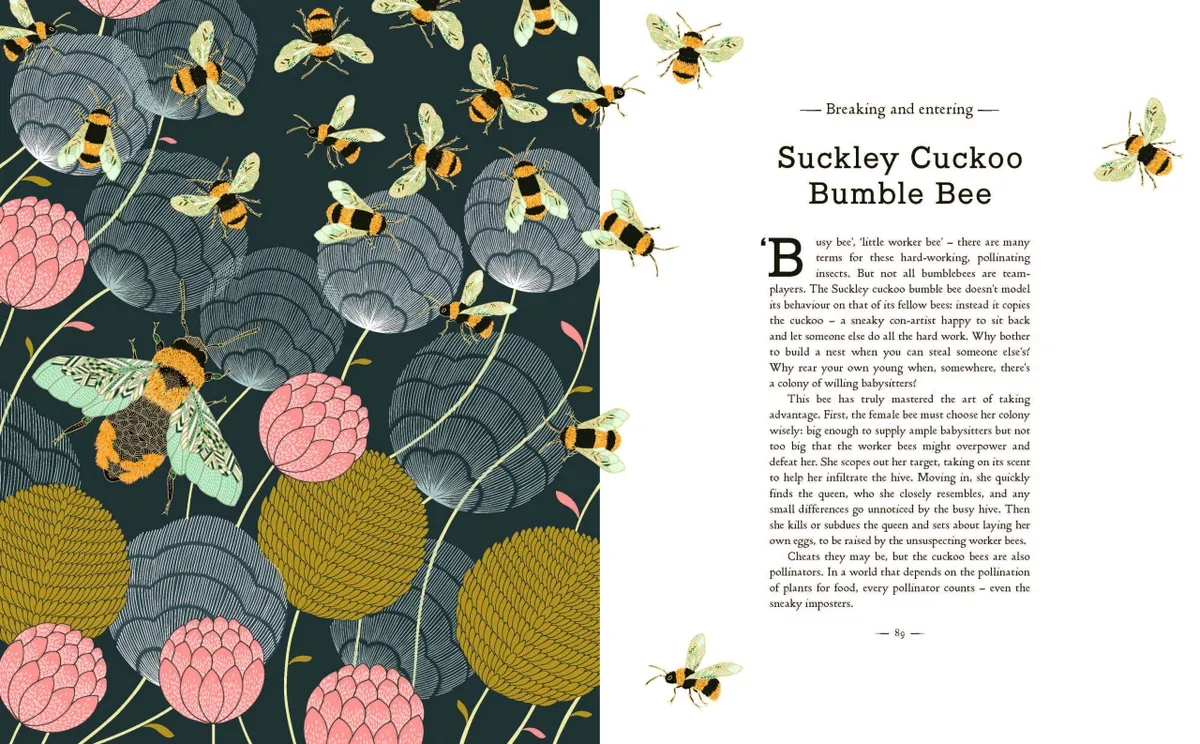
Her wandering albatross has a hint of Hokusai, and there’s something of William Morris in the axolotl. The species covered are varied, often elusive, far from obvious, and all the better for that.
My own wild child (aged 8) is already a font of wildlife facts but there was plenty in the book’s accompanying text to surprise, intrigue and delight both him and me. We don’t score books here but he gives this five out of five and so do I.
Reviewed by Amy-Jane Beer, wildlife writer
Get Your Boots On
By Alex White. Published by Dived Up.
- Published: 2019
- Formats: Paperback (£14.95)
- Age range: 13-18 years
Buy now from:

There have been so many books published about getting kids into wildlife and nature that my first reaction to Get Your Boots On was: do we need another one? But this one is different because it was written by a kid – well, okay, Alex White is a teenager, but hopefully he knows how they think.
He certainly seems to understand that some teenagers are put off wildlife- related hobbies because of what their friends think; that they rarely stop eating, and that expensive waterproof trousers can get ruined quickly out in the field.

The book covers all the basics of getting into wildlife, from fieldcraft and photography tips to getting connected with like-minded people. The chances are you know someone who really wants to know more about this funny business – this book would be the perfect present.
Reviewed by James Fair, environmental journalist
The Little Book of Rainforest Sounds
By Andrea Pinnington and Caz Buckingham. Published by Fine Feather Press.
- Published: 2019
- Formats: Hardback/Boardbook (£12.99)
- Age range: 3 years and above
Buy now from:

When I asked my five-year-old to help me review this book, his first impression was an instant thumbs up. It’s a classic format – press the buttons to hear 12 different sounds as you read.
But it packs a few surprises that elevate it beyond being simply a tropical ‘my first animals’ sort of affair. Atmospheric sounds of the rainforest augment every howl, whistle or grunt, giving a real sense of the jungle.

A selection of animals from off the beaten track includes tree hyrax, Goldie’s bird of paradise (my son’s favourite) and indri (mine). Each page sets the animal in question within its natural surroundings, and is full of the sort of facts that left my son and me staring dumfounded at each other (did you know that if you look through a tokay gecko’s ears you can see straight through its head?). Double thumbs up all round (‘toucan’ play that game).
Reviewed by Paul McGuinness, editor, BBC Wildlife Magazine
The Big Book of Birds
By Yuval Zommer. Published by Thames & Hudson.
- Published: 2019
- Formats: Hardback (£12.95)
- Age range: 6-8 years
Buy now from:

This generously proportioned hardback appeals to children’s natural curiosity. 26 double- page spreads pose bird-related questions (why is a flamingo pink?), furnish the answer (it eats shrimp) then offer four quirky titbits (a flamingo wees on its legs to cool down).
Spreads showcase ecological themes (such as nests and migration), individual bird species (including robins and red-crowned cranes) or families (albatrosses and hummingbirds), and offer practical advice (giving garden birds a home). The pages are busy with engaging illustrations that, enticingly, prioritise character over accuracy.

Regular anthropomorphism jars slightly (puffins ‘bump into’ and flamingos ‘dance with’ their ‘friends’) and the odd misguided statement is frustrating (urban peregrines nest on skyscrapers because it ‘reminds’ them of cliffs used ‘in the wild’). But such minor grumbles fail to detract from an enchanting product that provides perfect bird-oriented bedtime reading for inquisitive children and their parents.
There is an accompanying sticker book (paperback, £8.95): Amazon UK, Bookshop, Hive, Waterstones.
Reviewed by James Lowen, nature writer
Amazing Evolution: The Journey of Life
By Anna Claybourne, illustrated by Wesley Robins. Published by Ivy Kids.
- Published: 2019
- Formats: Hardback (£14.99)
- Age range: 9-12 years
Buy now from:

The next time I get my theories of natural, sexual and kin selection as mixed up with each other as a double helix of DNA, I’ll know where to go. Here are short, simple explanations of each one, with bonus, witty illustrations to drive home the point like a rutting red deer stag.
Amazing Evolution isn’t aimed at me, however, but my offspring, who are just another small step down the road in Homo sapiens becoming nothing more than a brain that survives entirely on fun-size chocolate bars.

Luckily, they loved it, too. My 10-year- old was constantly flicking through to the chapter that explains how wolves became dogs. He’s an expert on the subject now. I was most startled to find the evidence that we are genuinely still evolving – I didn’t know this about wisdom teeth or that about the plantaris muscle. You’ll have to read the book yourself to find out what I’m talking about.
Reviewed by James Fair, environmental journalist
The Sea: Exploring our blue planet
By Miranda Krestovnikoff, illustrated by Jill Calder. Published by Bloomsbury.
- Published: 2019
- Formats: Hardback (£12.99)
- Age range: 7-12 years
Buy now from:

‘It’s your work, Mummy, why do you want me to do it?’ My son just turned eight and is getting wise. He took some persuading when I asked him to co-review this colourful compendium. I lured him by suggesting that the author, the naturalist and TV presenter Miranda Krestovnikoff, is part zoologist, part-mermaid.
The book did the rest. There’s a beautiful balance of words and art – we loved the variety and authenticity of colours in Jill Calder’s habitat illustrations – you can almost hear the breeze on the clifftops, inhale the weirdly pleasing stink of saltmarsh, feel sundried salt crusting on your skin.

The text is authoritative, accessible and respectful (no ‘killer sharks’ or ‘cute dolphins’). The final spread on ocean plastic is timely but felt a bit of a bolt-on to a book that is otherwise celebratory, with other conservation issues not getting comparable treatment.
Read our Wildlife Champion interview with Miranda Krestovnikoff, where she explains why loves grey seals.
Reviewed by Amy-Jane Beer, wildlife writer
The Incredible Ecosystems of Planet Earth
By Rachel Ignotofsky. Published by Wren & Rook.
- Published: 2019
- Formats: Hardback (£12.99)
- Age range: 9-11 years
Buy now from:

It’s always fun to ask children what they think of the book they’re reading. Nine-year-old number one was all praise. He especially enjoyed the works of art that are the maps and flow diagrams (“very detailed but not complicated”). Nine-year-old number two was slightly more critical.
Her only gripe with the book itself was that the letter E is “written funny” in the annotations. (It is, too.) She was more disgruntled after reading about the extinction of the dodo. (Pity the poor, hungry sailor who ate the last one, should they ever meet.)
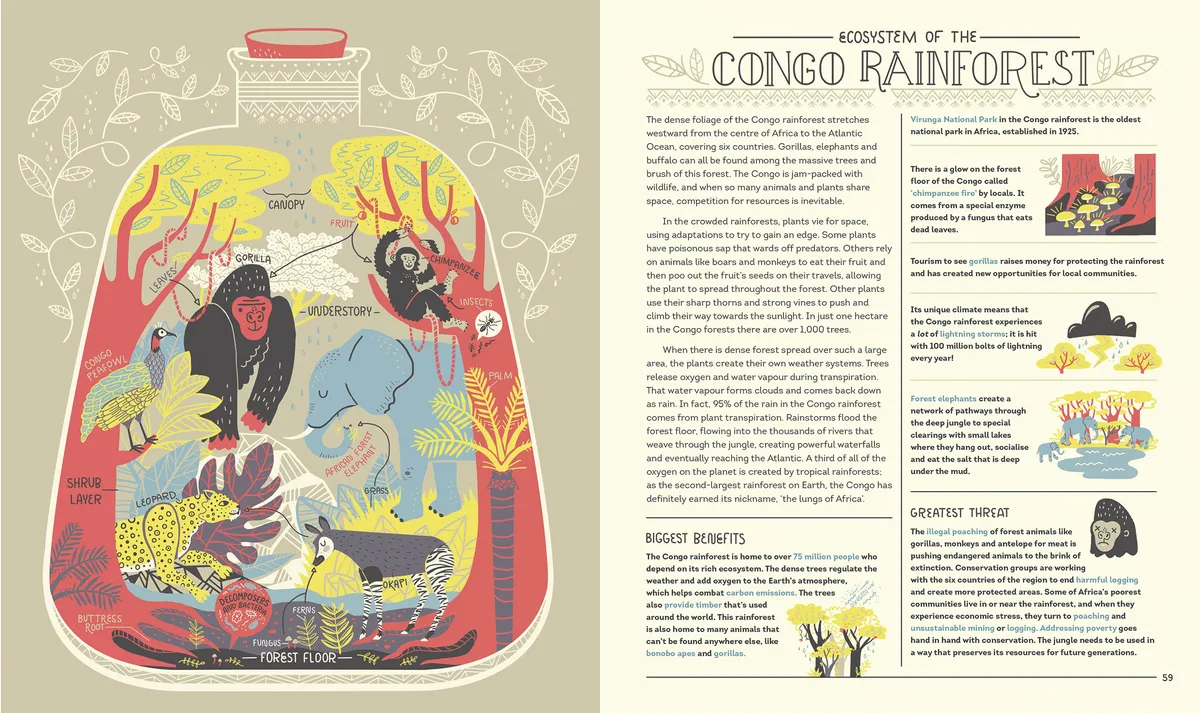
She’s “pretty sure,” though, that there’ll still be one or two hiding somewhere. This beautiful book is a treasure trove of facts, new words, concepts and ways of looking at the natural world.
Reviewed by Stuart Blackman, science writer
The Sea Book: Meet the marvellous creatures living in our oceans
By Charlotte Milner. Published by DK.
- Published: 2019
- Formats: Hardback (£12.99)
- Age range: 5-9 years
Buy now from:

I suspect Charlotte Milner is a fan of Octonauts. The BBC animated TV series, which has ‘edutained’ a generation of youngsters on the subject of marine biology, is echoed in both the artwork and text of The Sea Book. I couldn’t help hearing the voice of Shellington, the Octonaut’s scientific sea otter, when I read this book.
That’s not a criticism. Like Octonauts, The Sea Book places the planet’s oceanic zoological wonders in a wider ecology of food webs, ecosystems and planetary processes. Environmental concerns are raised, but without scaring the living daylights out of any children, or their parents. It is a masterful execution of Albert Einstein’s dictum that everything should be made as simple as possible, but no simpler.

But who cares what I thought? Over to my focus group of two eight-year-old children (at the older end of the target readership): “Some of it is a bit obvious,” said one (well, she did grow up watching Octonauts, after all), “but most of it is very interesting.” Her favourite fact was that zebra sharks have spots, not stripes. Meanwhile, it kept her brother completely quiet for a whole 18 minutes. As a parent, what more could you ask for?
Reviewed by Stuart Blackman, science writer
Beetle Collector’s Handbook
By M.G Leonard. Published by Big Picture Press.
- Published: 2018
- Formats: Hardback (£10.99)
- Age range: 8-12 years
Buy now from:

Grab your sweep net and find a quiet corner because this book is written in such an engaging way that young readers need to be prepared to share it or hide it from adults! The latest book by M.G Leonard, it takes the reader on a journey of entomological discovery that is as delightful as it is educational.
Written as a beetle guide by the fictitious father, ‘Monty G Leonard’, of Darkus, a character from the author’s previous Beetle Boy series, it is packed with facts and entertaining annotations whilst lavishly sprinkled with beautiful, anatomically correct drawings.

From describing beetle species to practical tips on how to find, capture and conserve with a comprehensive entomologist’s dictionary, the pages are a pleasure to turn. It is simply bursting with everything that is Coleoptera.
Reviewed by Sally-Ann Spence, entomology educator
We Build Our Homes
By Laura Knowles, illustrated by Chris Madden. Published by Words and Pictures.
- Published: 2018
- Formats: Hardback (£12.99)
- Age range: 4-7 years
Buy now from:

This boldly illustrated children’s book relates 26 double-page stories of ‘incredible animal architects’ that create remarkable structures in which to live, sleep, raise offspring, store food or impress a mate. The master builders are both familiar (moles) and oddball (meerkats).
Succinct text conveys image-rich detail. Weaver nests dangle ‘like colossal raindrops’; Darwin’s bark spider webs ‘stretch as far as three buses, end-to-end’. My daughter was entranced by edible-nest swiftlets building nest-cups with their own spittle, and termites converting their poo into citadels.

The concept is simple but clever. Focusing on a commonality between people and other animals – the need for a safe home – generates empathy. We may be the ‘land-takers, world-shapers’ but we share with other creatures ‘this one planet we call home’. A compelling book, gloriously executed.
Reviewed by James Lowen, nature writer
Red Alert!
By Catherine Barr, illustrated by Anne Wilson. Published by Otter-Barry Books, £12.99
- Published: 2018
- Formats: Hardback (£12.99), paperback (£8.99)
- Age range: 8-12 years
Buy now from:

While many children's non-fiction books prefer to sneak conservation messages in here and there, Red Alert! boldly chooses to put wildlife conservation front-and-centre.
Readers begin by choosing an animal on the IUCN Red List, whose fate they must uncover. Turning to the correct page, they are greeted with a scene in which their animal is posed, alongside a description of the conservation challengers it faces.
The 15 threatened animals featured are thankfully diverse. As well as familiar snow leopards are gharials and corals and a memorable peacock tarantula, a lonely victim of logging.

Vibrant, colourful spreads, which are as much abut the scientists working to limit extinctions are the animals themselves, remind readers that global conservation is a race and that there is an excitement in what scientists are working to achieve. Exposition is delivered here with refreshing humanity, inspiring readers to sit up, champion the challenges that animals face and take action.
Reviewed by Jules Howard, zoologist and wildlife writer
10 Reasons to Love ... a Penguin/Lion/Bear/Turtle/Elephant
By Catherine Barr, illustrated by Hanako Clulow. Published by Frances Lincoln Publishers.
- Published: 2017 - 2018
- Formats: Hardback (£9.99)
- Age range: 3-6 years
Buy now from:

Delightful illustrations in these titles gently entice children into the world of their animal subjects. The concept of this established series is neat: each spread celebrates an enchanting dimension in the life of these charismatic creatures, pairing the artwork with a paragraph or two of succinct text.
Young readers learn, for instance, that penguins have salty sneezes and burrow into their own poo, and that lions ‘flip’ porcupines and are partial to catnaps. They’re then primed with relevant ways to ‘show their love’, from researching green energy to sponsoring a wildlife charity.

The text occasionally overgeneralises to the point of inaccuracy (South Africa is hardly ‘near’ Antarctica), and undue artistic licence is sometimes taken (Adélie penguins have black bills, not red), but these are minor quibbles
Reviewed by James Lowen, wildlife writer
Know Your Nature: British Wildlife
By Caz Buckingham and Andrea Pennington. Published by Fine Feather Press.
- Published: 2018
- Formats: Hardback/boardbook (£8.99)
- Age range: 3-5 years
Buy now from:
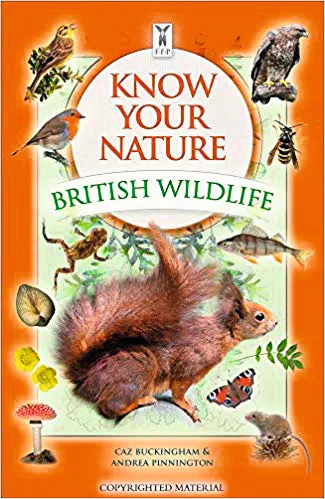
Nature must compete for children’s attention these days, so any book aimed at getting kids to turn off their devices and tune into wildlife should be applauded.

This accessible book is designed as a first step for youngsters keen to learn more. It’s not a field guide, but contains a small selection of Britain’s diverse flora and fauna. Each spread represents a category of our wildlife. The fun quiz at the back tests how much young minds have absorbed.
Reviewed by Mike Dilger, naturalist and broadcaster
The Little Book of the Dawn Chorus
By Caz Buckingham and Andrea Pinnington. Published by Fine Feather Press.
- Published: 2018
- Formats: Hardback/boardbook (£12.99)
- Age range: 3 years and above
Buy now from:

Nothing can beat experiencing the dawn chorus first hand, however, this enchanting book makes a fine hors d'oeuvre to prepare your family for the real deal. The Little Book of the Dawn Chorus is part of an ongoing series that aims to attune both young and adult ears to the sounds of Britain's wildlife. The book's unique selling point is its sound bar, which provides instant access to the vocalisations of ten commonly heard birds in spring.
To my five-year-old son, who was happy to test the title's appeal, the experience of pressing bird-emblazoned buttons for instant aural gratification were a hit. Within five minutes his restless little fingers had played each of the different songs countless times.
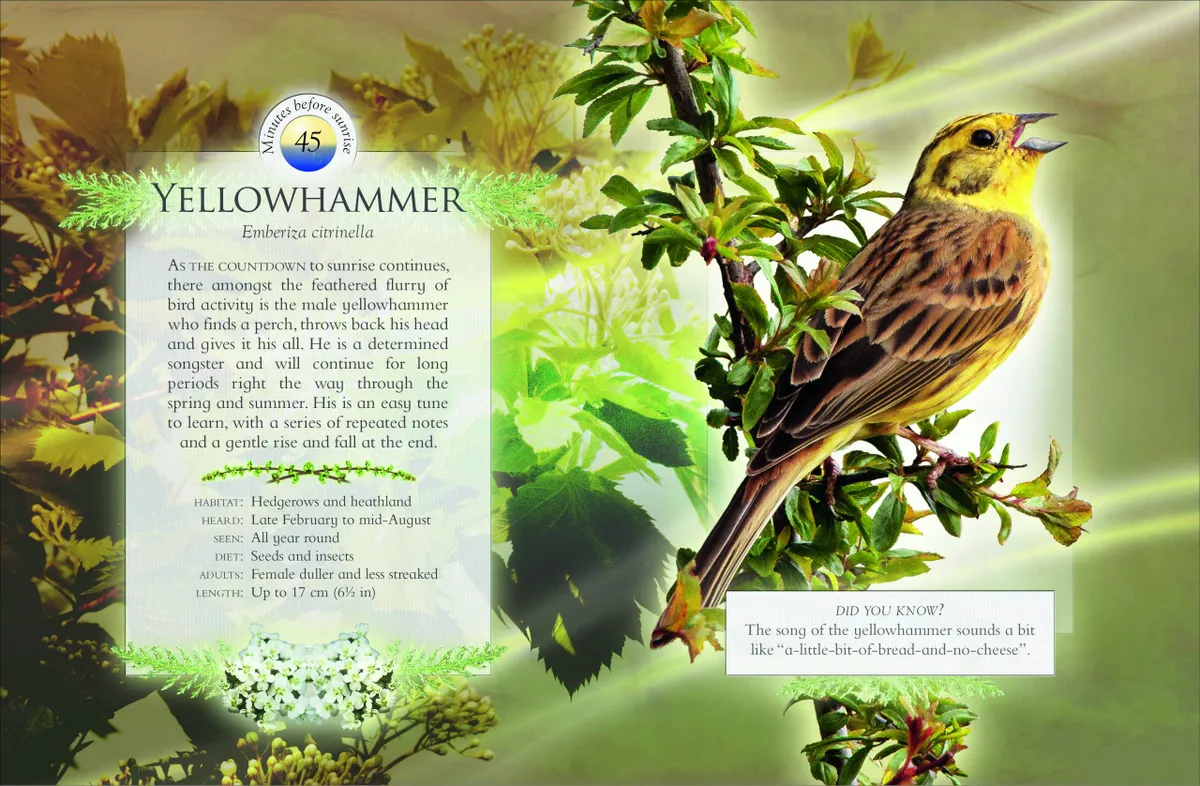
The carefully crafted text accompanying each species makes this book both fun and education but my only criticism would be the choice of the birds. I think blackcap and dunnock would have been better than swallow and house sparrow.
Reviewed by Mike Dilger, naturalist and broadcaster
I Am the Seed that Grew the Tree
Selected by Fiona Waters, illustrated by Frank Preston-Gannon. Published by Nosy Crow and the National Trust.
- Published: 2018
- Formats: Hardback (£14.99)
- Age range: 8-12 years
Buy now from:

My daughters loved dipping into this beautiful book, an anthology of 365 poems about the natural world, taking turns to read out their favourites. Most are short, some just a few lines long, and there are also haikus, limericks and tongue-twisters. Famous names crop up – Ted Hughes, Emily Dickinson, Robert Louis Stevenson and Benjamin Zephaniah, for instance – though many of the poems are anonymous.

This is a satisfyingly hefty book to hold, and the poems are framed by gorgeously immersive and colourful illustrations that evoke the four seasons: spring flowers, swooping swallows, shimmering shoals of fish, autumn leaves and wintry snowscapes. While a few words and verse structures are tricky, most of the poems can easily be managed by seven- to ten-year-olds.
Reviewed by Ben Hoare, editorial consultant, BBC Wildlife
When the Whales Walked
By Dougal Dixon, illustrated by Hannah Bailey. Published by Words & Pictures.
- Published: 2018
- Formats: Hardback (£12.99)
- Age range: 8-12 years
Buy now from:

Since evolution has become a popular primary school topic in the UK, a fleet of books on the subject has hit the shelves. Most opt for the all-too-familiar tale of the intrepid Darwin aboard the HMS Beagle and finches in the Galápagos, or the peppered moths that would follow.
Here, Dougal Dixon and illustrator Hannah Bailey opt for something else, offering 13 stories about the early experimentation of animal forms in a bid to help younger readers understand how we got here. Besides the eponymous whale, there are chapters on early dinosaur flight and warm-blooded crocodiles, alongside more familiar stories of snakes with legs and fish with feet.

Delivered with playfulness, colour and charm, Dixon’s aim is clearly to ‘show and don’t tell’, drawing readers in with wonder, rather than dry evolutionary exposition. The book achieves this with great success.
Reviewed by Jules Howard, zoologist and wildlife writer
So you think you know about Tyrannosaurus rex / Triceratops / Diplodocus / Spinosaurus / Velociraptor / Stegosaurus?
By Ben Garrod. Published by Zephyr.
- Published: 2018
- Formats: Hardback (£6.99 each)
Buy now from:

How much do you think you know about dinosaurs? Prepare to have your dint-world turned upside down as you're taken on an incredible illustrated journey through time.
Garrod writes flawlessly with his own unique blend of well-honed skill as a scientist as well as the contagious curiosity and endless exploratory mindset usually reserved for children. It feels like he's sitting right there with you, helping you to ask and answer all the right questions, with a perfect combination of humour and expert knowledge.
He uses stories from his life, alongside interviews with a number of palaeontologists that can't help but leave you feeling inspired. Included are practical guides to fossil hunting and quizzes to test your knowledge, together with the latest dinosaur research ensuring the everyone discovers something new.

These books will leave you thirsting to know even more about the incredible history of life on Earth and are a perfect primer for kids to learn more about the amazing 'terrible lizards'.
Reviewed by Jon Tennant, palaeontologist
The Coral Kingdom
By Laura Knowles, illustrated by Jennie Webber. Published by Words & Pictures.
- Published: 2018
- Formats: Hardback (£12.99)
- Age range: 5-7 years
Buy now from:

This beautifully illustrated book will be pulled off the shelf time and time again, artfully combining rhythmic verse for younger listeners with interesting and accurate content to keep older children engaged. Flipping through the pages is rather like floating over a real reef, with colourful new vistas and different species at every turn.
The huge cast of both familiar and lesser-known reef characters is introduced on the inside covers, adding a puzzle dimension to the book as you search for the royal blue tang, star coral and cone snail.

Though it ends with a strong ecological message about coral bleaching, featuring key facts and the actions we can all take to safeguard the sea, it first and foremost immerses children in the colourful, diverse and fascinating world of the coral reef.
Reviewed by Sue Ranger, engagement and education manager, Marine Conservation Society
A Book of Bears: At home with bears around the world
By Katie Viggers. Published by Laurence King.
- Published: 2018
- Formats: Hardback (£11.99)
- Age range: 4-7 years
Buy now from:

Ursids are a cultural phenomenon, immortalised in many children’s characters, from Paddington and Winnie-the-Pooh to, er, Bungle. So, this fun-filled look at the world’s eight species is a must for any child under 10. The illustrations are cartoon-like but there are plenty of hard facts, too.

The dietary details can feel a trifle misleading (sun bears don’t only eat honey-related products, surely), but that’s a minor quibble.
Reviewed by James Fair, environmental journalist
Howl Like A Wolf!
By Kathleen Vale, illustrated by Kaley McKean. Published by Storey Publishing.
- Published: 2018
- Formats: Hardback (£14.99)
- Age range: 6-9 years
Buy now from:

“Have you tried any of the activities in the book?” I asked my 10-year-old son in preparation for this review. “Well,” he replied sheepishly, “I did pee on a tree to mark my territory.” In fact, Howl Like a Wolf rather conservatively suggests “scratching the ground” or “putting up flags” to do this, even though wolves use “smelly pee and poop” in real life.

I then persuaded my seven-year-old to sneak up on his mum like a leopard while she was putting clothes away. The point is that children learn about the biology of animals by imitating them, and this engaging book offers ideas to emulate 15 species – whether wriggling through tight spaces like an octopus, dressing in stripy clothes like a skunk or flicking out your tongue to eat popcorn off a table, like a frog.
“Why don’t you try singing like a humpback in the bath?” I suggested later. “Just don’t practise any breaching.”
Reviewed by James Fair, environmental journalist
A World of Birds
By Vicky Woodgate. Published by Big Picture Press.
- Published: 2018
- Formats: Hardback (£14.99)
- Age range: 7 years and above
Buy now from:

As children, many of us probably spent more than one wet day poring over Dorling Kindersley-style illustrated books, eagerly taking in the facts and figures.
Vicky Woodgate’s A World of Birds uses a similar fact-based approach to introduce a selection of 75 species from across the globe, from magnificent frigatebirds to kingfishers to eclectus parrots. Special adaptive features are picked out, along with various quirky snippets on behaviour and biology.
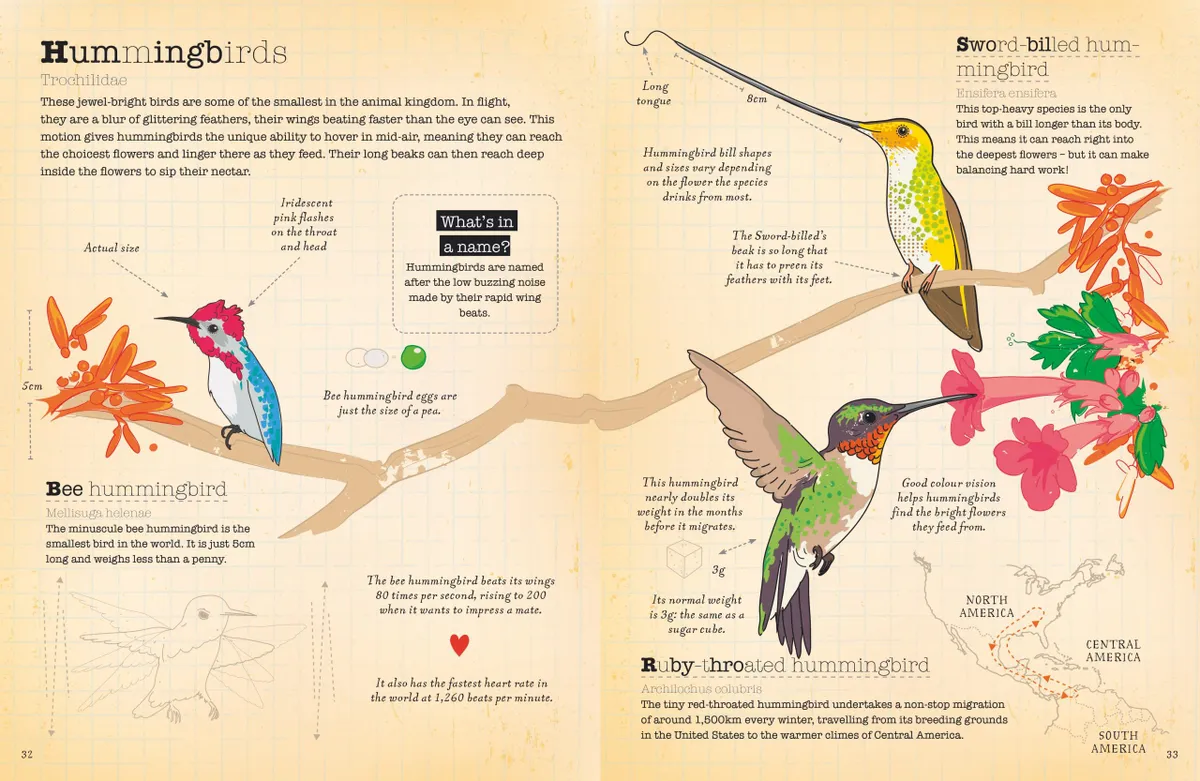
While my three-year-old enjoyed the colourful illustrations and pointing out the species he recognised, the book’s main appeal will be to slightly older children, who will no doubt delight in reciting their new-found knowledge: wild turkeys, for instance, can run at speeds of up to 40kmph; bee hummingbird eggs are the size of peas; and kingfishers have a third, transparent eyelid.
Reviewed by Kate Risely, British Trust for Ornithology
The Big Book of the Blue
By Yuval Zommer. Published by Thames & Hudson.
- Published: 2018
- Formats: Paperback (£8.95)
- Age range: 3-5 years
Buy now from:

In this lively follow-up to Zommer’s previous Big Books of Beasts and Bugs, kids are encouraged to think about how sea creatures communicate, swim and eat.
They’ll learn how anglerfish use dangling lights to lure prey; how the flattened tails of sea snakes power them through the water; and how seahorses grip seaweed with their tails. Minor inaccuracies aside (‘humpbacks’ are clearly sperm whales), this is a colourful treat for youngsters.
There is an accompanying sticker book (paperback, £8.95): Amazon UK, Bookshop, Hive, Waterstones.
Reviewed by Paul Bloomfield, freelance writer
Rainforests in 30 seconds
By Jen Green, illustrated by Stef Murphy. Published by Ivy Press.
- Published: 2017
- Formats: Paperback (£7.99)
- Age range: 8-11 years
Buy now from:

Agreed seven, my inaugural rainforest experience came courtesy of Sir David Attenborough, in Life On Earth. My daughter is now the same age: Sir David similarly introduced her to the world's richest habitats through Planet Earth II. This piqued her interest about Daddy's years working in jungles. Appetite whetted, she can depend her understanding through this charming book.
Prolific author Jen Green caters for short attention spans among readers aged 8-11, catering admirably through 30 topics encompassing the what, where and how of rainforests, plus their wildlife, human residents and - importantly - threats.
Subjects are granted a three-second summary, 30 seconds of fact-packed text (which actually takes nearer a minute to read) and a welcome three-minute 'mission' inviting kids to study camouflage or survey mini beasts.

The book isn't perfect. Odd factual glitches include an assertion that sloths favour the rainforest understory (rather than the canopy). But such minor grumbles do not detract from a well-presented product.
Reviewed by James Lowen, wildlife writer
The Ways of the Wolf
By Smriti Prasadam-Halls, illustrated by Jonathan Woodward. Published by Wren and Rook.
- Published: 2017
- Formats: Hardback (£12.99)
- Age range: 9-11 years
Buy now from:

This is a beautiful book. Jonathan Woodward's illustrations are moody, intense and mysteriously wolfy. I keep returning to the centrepiece - a depiction of shadowy wolves creeping across a midnight landscape.
The writing is succinct and lucid, communicating to children what they need to know about wolf biology, geographical range, place in the ecosystem and current threats.
I do have a few tiny quibbles, however. It is perhaps not strictly true that wolves post little threat to humans: in India, they are blamed for numerous casualties. And their 'shyness' may not be a fixed characteristic. I suspect they were bolder in the past and, as we cease persecuting them, that they will become bold again.
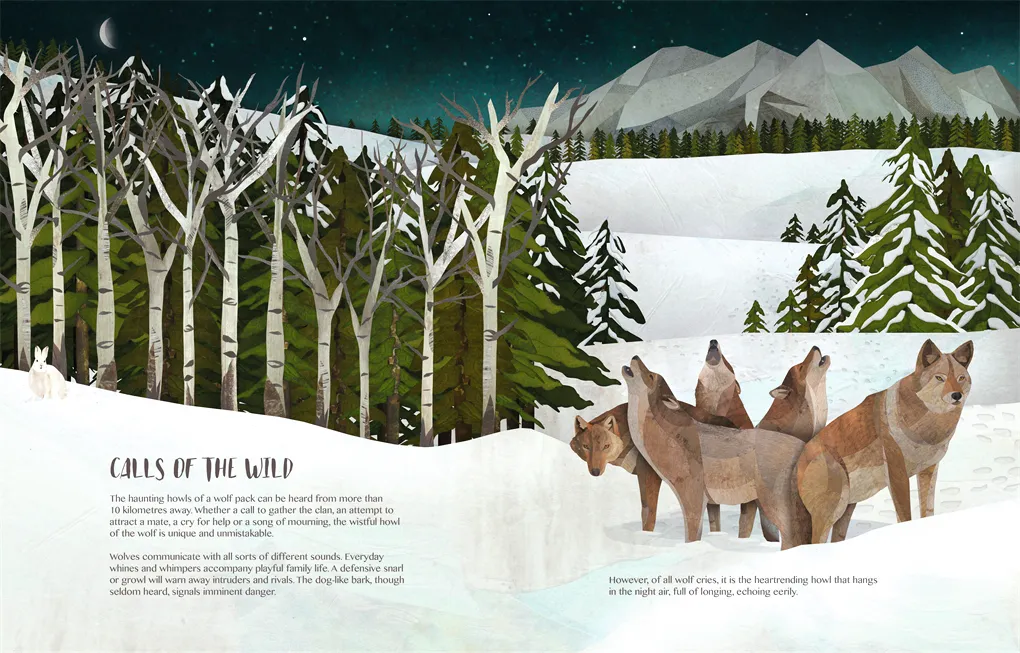
It's the pictures that carry the book. I would love to own the originals. In fact, I suggest you buy two copies: one for the bookshelf, and the other (dear oh dear) to dismember and paste lovingly across the children's bedroom walls.
Reviewed by Stephen Mills, wildlife writer
Does It Fart? The Definitive Field Guide to Animal Flatulence
By Dani Rabaiotti and Nick Caruso, illustrated by Ethan Kocak. Published by Quercus.
- Published: 2017
- Formats: Hardback (£9.99), Paperback (£7.99)
Buy now from:

At first glance, this seems like toilet humour. And to be honest, it is. But this book is also so much more than that. Prompted by a question on Twitter about whether snakes fart, which then evolved into an online spreadsheet, this book is relatively simple – the authors discuss whether a creature can fart.
They delve into the science of why some animals fart, why some don't, why some don't but could, and which species' flatulence we just don't know about, as well as the smells, the associated behaviours and more.
It's an engrossing and surprising read for both children and adults alike. A version for younger children has also been created (paperback, £6.99): Amazon UK, Bookshop UK, Hive, Waterstones.
Reviewed by Megan Shersby, editorial and digital co-ordinator, BBC Wildlife
True or Poo? Full of Filthy Animal Facts & Falsehoods
By Dani Rabaiotti and Nick Caruso, illustrated by Ethan Kocak.
- Published: 2018
- Formats: Hardback (£9.99), Paperback (£8.99)
Buy now from:

In the follow-up to their New York Times bestseller Does It Fart?, zoologist Dani Rabaiotti and ecologist Nick Caruso take on a new challenge with True or Poo?
This time they investigate a range of animal myths, some of which have perpetuated for centuries. For example, ‘scorpions can die of constipation if they shed their tails’ (true), ‘all moths eat clothes’ (poo) and ‘earwigs lay eggs in your ears’ (also poo). As usual, the fascinating scientific facts are accompanied with delightful illustrations by Ethan Kocak. A version for younger children has also been created (paperback, £6.99): Amazon UK, Bookshop UK, Hive, Waterstones.
Reviewed by Megan Shersby, editorial and digital co-ordinator, BBC Wildlife
Believe It Or Snot. The Definitive Field Guide to Earth's Slimy Creatures
By Dani Rabaiotti and Nick Caruso, illustrated by Ethan Kocak. Published by Quercus.
- Published: 2019
- Formats: Hardback (£9.99), Paperback (£8.99)
Buy now from:

Scientists Dani Rabaiotti and Nick Caruso, along with illustrator Ethan Kocak, have teamed up once again to explore some of the weird and wonderful creatures found on our planet. In their third (and possibly final) book, they tackle the slippery subject of sliminess.

Each creature in the book is awarded a rating between zero and five slime droplets, with the latter being awarded to only one outstandingly slimy animal. As with their previous books, the authors combine their wicked humour with fascinating information.
Reviewed by Megan Shersby, editorial and digital co-ordinator, BBC Wildlife
Wicked Bugs
By Amy Stewart, illustrated by Briony Morrow-Cribbs. Published by Algonquin.
- Published: 2017 (younger readers edition)
- Formats: Paperback (£10.99)
- Age range: 8-12 years (younger readers edition)
Buy now from:

Yuck – exactly the response you need to capture the attention of an eight- to 12-year-old. Before they’ve decided to be afraid of creepy-crawlies, or too cool for wildlife, kids are enthralled as they experiment with the emotions of fear, disgust, excitement and awe. They’ll get them all here in droves, but woven through the gruesome facts are scientific facts too.
Author Amy Stewart offers up just the right balance in the gory details to get them hooked, but at the same time educated by the ecological lessons and anatomical details with which the text is littered.

From the frustrating familiarity of head-lice and the bizarre mystery of the once famine-threatening Rocky Mountain locust, to intestinal worms and the foot-hollowing chewings of the chigoe flea, Stewart does not hold back from the stomach-churning anecdote. She does, however, avoid tabloid sensationalism, and on the way she dispels some of the silly myths about black widow dangers and deathwatch beetle omens.
Reviewed by Richard Jones, entomologist
Main image: Father and daughter reading in bedroom. © MoMo Productions/Getty

